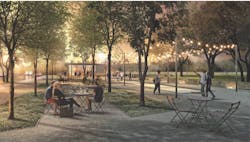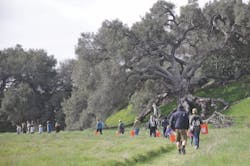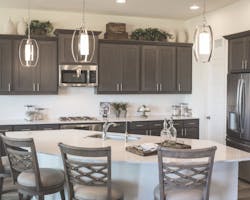Developing the Future in Master Planned Communities
At the heart of 23,000-acre Rancho Mission Viejo, a master planned community (MPC) in Orange County, Calif., is a 172-year-old working cattle ranch—the only remaining one in a county that once teemed with them. The development’s growing neighborhoods, which eventually will sprout 14,000 homes, are rising around a 17,000-acre permanently protected habitat reserve, where cowhands raise the cattle. Inside the community’s gates, homeowners can work alongside farmers tending Orange County’s largest citrus orchard, chicken coops, and three working farms that produce row crops and herbs.
Community members can share a huge prep kitchen and dining tables, partake of the harvest, and take lessons in farming skills, cooking, and sustainable landscaping. Or they can hike, learn about native wildflowers, tell stories around a campfire, and gaze at stars on Astronomy Night. “Today, good master plans are focusing more than they ever have on people being connected,” says Paul Johnson, Rancho Mission Viejo’s SVP of community development. “It used to be we could throw down houses and people would move in just for the house. Now, we think of the house, the neighborhood, how the neighborhood intermixes into the whole plan, and how the whole plan intermixes into the surrounding community. It’s about lifestyle.”
Indeed, says Jimmy Ayala, San Diego division president for Pasadena, Calif.-based Pardee Homes, which develops and builds in MPCs: “It’s not your father’s master planned community anymore.” Chances are, it’s not your children’s, either. What’s emerging as the go-to model for today’s master plan—grand in both size and amenities—is unlikely to repeat itself for even a generation, as available green space contracts and the demands of homebuyers expand. “In a time period when [master planned communities] are reshaping more radically than they ever have in the past,” Johnson says, “it looks like in 10 years, they will reshape again.”
But what shape the communities will take is anybody’s guess. Developers and big builders that populated the sprawling suburban master planned communities of the past few decades probably didn’t imagine what Craig Martin, a founding partner of Windsong Ranch developer Terra Verde Group, calls the walkable mini-towns that characterize today’s everything’s-included version of those blander developments. For today’s plans-in-progress, Johnson says, “The vision will change, depending on what the homeowner will want.”
Getting Access to Developable Land
Much depends on how much land developers can get their hands on. The number of legacy landowners willing to hand their long-held property over to developers is limited, and the inventory of undeveloped land up for grabs by those that can afford to acquire it is thinning out. Especially in Florida, California, and Texas—today’s sweet spots for master plans—a lack of land could force developers to whittle down the size of future communities. “Land is going to tell the story,” says Will Holder, president of Houston-based builder Trendmaker Homes, a division of TRI Pointe Homes.
Jody Kahn, SVP of research for John Burns Real Estate Consulting, notes, “We could see some really big ones, still.” But in areas where land is tight, she says, developers may not find enough to allow for mega-communities such as Orange County’s Rancho Mission Viejo and Whisper Valley, in Austin, Texas, which, at buildout, will include 7,500 single- and multifamily homes. “We could be looking at more modest master plans,” she says.
Teri Slavik-Tsuyuki, a marketing strategist and one-time chief marketing officer and SVP for San Diego-based master plan developer Newland Communities, notes that Millennial couples are interested in smaller, easier-to-care-for, more affordable homes that leave them the financial freedom to work fewer hours or stoke their sometimes-costly adventurous side.
And, as master plans shrink in size, so will the number of amenities they can accommodate. Yet homebuyer demand for homes close to coffee shops, hiking trails, and activities is unlikely to wane, Kahn says, so where developers choose to build their pared-down places could become even more important than what they put inside of them. “Your biggest amenity might be what’s outside your gate: a great location, a great school district, [being] minutes from the beach, nice shopping, major stores,” she says.
Not every master planned community will sprawl across an expansive swath of land; some will squeeze into urban infill lots. And Johnson foresees a not-too-distant era of vertical communities—skyscrapers filled with 1,000 or more condominiums or apartments that share a building with the same kinds of grand amenities, including pools, communal kitchens, club rooms, and shopping, that appeal to today’s master plan homebuyer. Among the first will be Greenpoint Landing, a 22-acre master planned development by New York’s Brookfield Properties under construction on the Brooklyn waterfront that will comprise 11 residential towers with 5,500 housing units, public spaces, parks, a public school, and a spate of retailers.
Amenities Set Master Planned Communities Apart
In the meantime, sales at master planned communities rose 9 percent last year and accounted for 3 percent of all new single-family home sales nationwide, according to John Burns. The consulting firm notes that among the top 50 developments in 2016, master planned communities logged record net sales of 24,374 units, up from 22,447 the year before.
Like all MPC developers, the Top 50 are planning for what could be a decade or more of new homes and neighborhoods as they do their best to accommodate the kinds of communities homebuyers want now and predict what they’ll demand three to 10 years out. “There’s no one answer, no cookie-cutter approach,” Slavik-Tsuyuki says.
“Except for the principles of good design, there is no recipe.” One thing is certain: The kinds of amenities a community offers—now and in the future—will set it apart from its competitors. The most progressive master planned communities, Slavik-Tsuyuki says, are laser-focused on creating “a sense of place” for their homeowners.
Hence, Rancho Mission Viejo’s centerpiece is a cattle ranch. Similarly, Tampa, Fla.-based Metro Development Group is building the first of four planned resort-style Florida communities that feature a 7- to 10-acre crystal-clear lagoon surrounded by sandy beaches. In Denver, The Meadows has a 200-step incline, which residents climb for exercise and to take in views of the town of Castle Rock.
Nocatee, in Florida, boasts a number of zip lines; a “giving tree” at Arizona’s Verrado—a tree with an expansive canopy—symbolizes the community’s focus on philanthropy. Viera, in Brevard County, Fla., donated land on its fringe to a local zoo, which has drawn animal lovers to settle there. “To put it into one word,” Martin says, "it’s lifestyle. It’s not just delivering a nice house on a nice lot. It’s the community.”
Martin’s 2,030-acre Windsong Ranch, which eventually will include 3,100 single-family homes, hosted 81 events for residents last year, including luaus, movie nights, cooking classes, happy hours, and fly-fishing lessons. Today’s developers are creating—and tomorrow’s will create—with a “finer level of detail … rather than putting in the same-size lots and doing everything in a big whitewash,” Slavik-Tsuyuki says. “It’s making master planned communities better for the future.”
But amenities will change, depending on what research reveals about buyers’ lifestyle preferences over the years. Slavik-Tsuyuki foresees communities with incubator spaces and pop-up retail stores where future residents can debut their start-up businesses. “Society has changed and will continue to,” she says. A 2017 Gallup survey estimated that 43 percent of employed Americans spend at least some of their week working from home. With a nod to the Millennial-fueled sharing economy, tomorrow’s MPCs may dabble in co-housing, which features shared spaces such as large kitchens and laundry rooms.
Broad Demographics Living Together
Future developers will focus less on the traditional master plan buyer—the young family—and more on single Millennials and empty nester Boomers. Kahn predicts that those groups will live in the same communities, but in homes and neighborhoods different enough to cater to each. Developers are inviting builders of product ranging from affordable rentals to luxury single-family homes to populate rings of neighborhoods in the same planned community. Apartment complexes and 55-plus neighborhoods are close enough that the two groups can share amenities, but far enough apart that 55-plus residents can swim in child-free pools.
In between, townhomes or duplexes could sprout up behind apartments; small, single-family homes will occupy the next ring; move-up homes will draw Millennials once they begin their delayed foray into parenthood; and luxury homes or age-restricted enclaves will bring up the rear, according to Martin. “We’re seeing lateral moves already,” he says, of Windsong Ranch, which opened in 2015.
“The goal of many of these people is to never leave the community.” Communities that combine housing for singles and young families with separate-but-nearby digs for grandparents are doing well, says Kahn, adding that the mix is a win for everyone. Steve Cameron, president of Newport Beach, Calif.-based developer Foremost Cos., agrees. “The combination of age-qualified and market rate in a combined master plan is a relatively new phenomenon,” he says. “It’s a terrific opportunity to create a community with two different age demographics living side by side: grandma and grandpa living near their grandchildren, but not too close.”
Getting Outdoors, and Green as a Given
Getting the grandparents to move out of the homes where they raised their families, however, requires “a compelling reason,” notes Cameron, whose 961-acre Terramor has reserved 1,000 of its eventual 1,400 homes for 55-plus buyers. Part of it, he says, is the community’s focus on indoor-outdoor living. Kahn notes that most successful master planned communities have created hiking and biking trails and walkways that connect neighborhoods with amenities such as coffee shops, retailers, and offices. Many, like Mission Rancho Viejo, tip a hat to the heritage of their locations. Millennials, Kahn says, care about sustainability and want to live in places that celebrate the environment. To that end, Ayala notes, most master planned communities are foot-friendly. Residents can walk from their homes to the neighborhood’s schools, shops, and restaurants within about 15 minutes.“Our parents’ master planned communities probably required a vehicle to get from one end to the other,” Ayala says.
Some communities are reaching even further in their effort to brand themselves as sustainable. All homes in Austin’s Whisper Valley, for example, are Zero Energy Ready, which means they are capable of offsetting all or most of their annual energy consumption. Boston-based developer Taurus Investment Holdings installed an underground geothermal loop field, which all of the homes will use as their source for heating and cooling. Although geothermal can halve the cost of a homeowner’s heating bill, Douglas Gilliland, Texas and Colorado managing director for Taurus, says builders didn’t embrace it at first.
“Production builders have a very fixed model that they build their homes to; that’s one of the ways they achieve efficiencies,” the developer explains.
But he says most eventually warmed to the technology. In addition, each home comes with rooftop solar panels and energy-efficient lighting and appliances. And they are prewired for charging stations, in anticipation of a surge in popularity of electric cars. “I’ve seen a lot of the cookie-cutter-type communities, and a lot of times their most appealing amenity was price,” Gilliland says, noting that the energy-efficient features in Whisper Valley homes add between $20,000 and $35,000 to the selling price. “Consumers today simply want more,” he says. Whisper Valley offers fixed-price financing for the up-front investment. “The fixed payment,” he adds, “is often less than the cost of the energy they’re saving.”
What’s Next in Master Planning?
“The way to be innovative in a master planned community,” Slavik-Tsuyuki notes, “is to go back to, ‘Who will live here and how do they want to live?’ and to resist the temptation to do the stuff that we’ve always done before.”
To offer community, connection, services, and infrastructure is essential. Located on the site of a decommissioned Naval Air Station 12 miles from Boston, Union Point is a 1,500-acre master planned development situated where three suburban towns intersect, just a 10-minute walk from commuter rail. The MPC is also designed to adapt to electric driverless shuttles, has garages retrofitted for other uses, and includes flexible, multiuse streets. LStar Ventures, Elkus Manfredi Architects, and Sasaki Associates have collaborated on the town, which offers entertainment, sports, art, culture, and education, as well as open spaces and pedestrian- and bicycle-friendly roadways.
Some 4,000 residential units, 1,000 acres of green space, and 50 miles of hiking/biking trails are planned, plus ample commercial development, office space, and retail space, as well as food and beverage options. The creators aim to offer the perks of urban density in a place that meets residents’ needs for convenience and quiet at the same time.
Sharon O’Malley is a writer, editor, consultant, and journalism professor based in College Park, Md.




